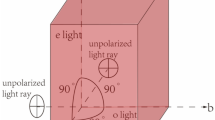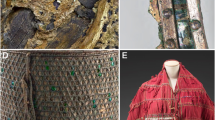Abstract
WOOL1, bleached by light, acquires some of its colour, becoming bluer in blue light or greener in green light. Reflectance and transmittance rise near the wavelength of the light because photons eliminate their particular absorbers, leaving the remainder of the chromophore unchanged. This phenomenon, which we named “spectral conformity”, was used, for example, in traditional wool bleaching by sunlight. Blue photons in daylight (spectral maximum in the blue2–5) eliminate the absorbers of blue photons that made the wool yellow, thus making it bluer, and looking “whiter”. Cotton, linen, paper and so on, used to be sun-bleached. The question arises: is spectral conformity general or is it an interesting peculiarity of wool ?
This is a preview of subscription content, access via your institution
Access options
Subscribe to this journal
Receive 51 print issues and online access
$199.00 per year
only $3.90 per issue
Buy this article
- Purchase on Springer Link
- Instant access to full article PDF
Prices may be subject to local taxes which are calculated during checkout
Similar content being viewed by others
Change history
01 May 1968
In the communication "Spectral Conformity? a Widespread Effect of Light" by Herbert F. Launer (Nature, 218, 161; 1968) the sentences beginning on the eleventh line of the second paragraph of page 163 should read: "Absorber formation poses a problem, however, because photons of green and blue light ordinarily lack the energy to break bonds.
References
Launer, H. F., Textile Res. J., 36, 606 (1966).
Condit, H. R., and Grum, F., J. Opt. Soc. Amer., 54, 937 (1964).
Taylor, A. H., and Kerr, G. P., J. Opt. Soc. Amer., 31, 3 (1941).
Brackett, F. S., in Biol. Effects Radiat. (edit. by Duggar, B. M.), 1, 172 (McGraw-Hill Book Co., New York, 1936).
Hirt, R. C., Schmitt, R. G., Searle, N. D., and Sullivan, A. P., J. Opt. Soc. Amer., 50, 706 (1960).
Launer, H. F., Textile Res. J., 35, 395, 813 (1965).
Launer, H. F., Textile Res. J., 33, 258, 910 (1963).
Author information
Authors and Affiliations
Rights and permissions
About this article
Cite this article
LAUNER, H. Spectral Conformity—a Widespread Effect of Light. Nature 218, 161–163 (1968). https://doi.org/10.1038/218161a0
Received:
Revised:
Issue Date:
DOI: https://doi.org/10.1038/218161a0
Comments
By submitting a comment you agree to abide by our Terms and Community Guidelines. If you find something abusive or that does not comply with our terms or guidelines please flag it as inappropriate.



